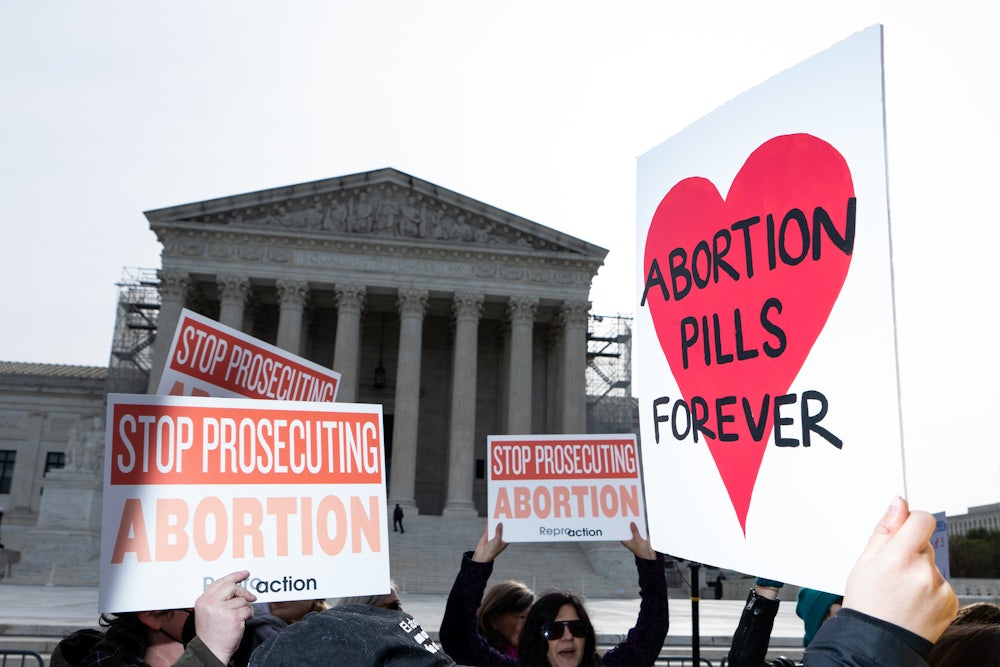The Supreme Court issued a unanimous opinion Thursday rejecting an anti-abortion group’s attempt to greatly restrict access to the drug mifepristone, one of the pills used in medication abortion.
Since the Supreme Court reversed Roe v. Wade in June 2022, the anti-abortion movement has worked aggressively to ban mifepristone, part of a two-drug regimen that is now the most common way to terminate a pregnancy in the United States. The case decided Thursday was brought by a group founded seemingly for the express purpose of bringing it, an ad hoc association of anti-abortion doctors who claimed they were harmed by current regulations on mifepristone. That group, the Supreme Court has now decided, lacked standing; in other words, these anti-abortion doctors failed to demonstrate—wild, I know—that they were harmed by other people’s abortions.
While the court’s ruling in Alliance for Hippocratic Medicine v. U.S. Food and Drug Administration may seem like a reprieve for mifepristone, it is primarily a rebuke of this particular approach to banning medication abortion—one that never should have made it to the Supreme Court at all. It also represents a setback for the Christian nationalist law project behind the case, Alliance Defending Freedom, a setback worth celebrating, if only because ADF’s attempt to manufacture a plaintiff for the sake of advancing its political goals has failed.
Not long after the Dobbs decision in 2022, Alliance Defending Freedom began crafting what became its next high-profile line of attack on abortion, involving a newly formed anti-abortion group, Alliance for Hippocratic Medicine. The speedy, opportunistic way this case came together should have cast enough doubt on its merits, as well as revealed its aims: to create confusion and peddle misinformation about the safety and lawfulness of medication abortion. Each time a court entertained this case, making mifepristone briefly a national headline story, it risked misinforming people seeking an abortion—by laundering junk science about mifepristone into court filings, or casting doubt on the safety of dispensing the drug through telehealth. It is possible this legal challenge did more to make people fearful of the consequences of having an abortion with mifepristone than it was ever going to do to actually change the regulations on dispensing mifepristone.
The plaintiff, Alliance for Hippocratic Medicine, or AHM, purports to represent thousands of medical professionals who are opposed to abortion. Some were named as individuals in the legal challenge as well, such as a Republican state senator and emergency room physician from Indiana, Tyler Johnson. According to his sworn declaration in the legal challenge, Johnson claimed that patients may “experience trauma” from taking mifepristone, or may not “understand what the drugs will do to them,” or may even lie about having taken mifepristone—a choice that might be understandable, when abortion is considered a crime. At the same time, Johnson also maintained that patients who took mifepristone were “unnecessarily presenting in the emergency department,” taking time away “from other patients who need it.” While he was involved in the AHM challenge to mifepristone, Johnson was the subject of a malpractice lawsuit brought on behalf of one of his E.R. patients, who died not long after she gave birth.
Alliance for Hippocratic Medicine only incorporated as a group in the weeks after Dobbs. They chose to file in August 2022 for incorporation in Amarillo, Texas, perhaps the most favorable jurisdiction in the country for the case they would soon bring against mifepristone. Unsurprisingly, they apparently did not conduct any programs or activities in Amarillo and seemingly only created the organization for the purpose of bringing suit. Then, with a paltry annual income of less than $50,000, they got the legal team that won the Dobbs case to represent them, brought their case before Matthew Kacsmaryk, a judge all but handpicked to favor them, and, within months, were headed to the Supreme Court. It’s not much of a mystery how this happened, as neither group tried very hard to conceal the paper trail. “Alliance for Hippocratic Medicine is nothing more than a brand name that Alliance Defending Freedom used to shop this abortion pill case up to the Supreme Court,” Caroline Ciccone, president of Accountable.US, told The New Republic in March.
It’s not the first time Alliance Defending Freedom has all but manufactured a plaintiff for the sake of advancing one of its broader goals—whether that was attacking abortion access, as it did in this case, or providing legal cover for anti-LGBTQ discrimination, as it did last year. In that case, 303 Creative LLC v. Elenis, the court ruled in favor of ADF’s client, a web designer who claimed she was injured by anti-discrimination laws that would apply if she refused to design a website for a same-sex wedding. (The same-sex-wedding website request she claimed to have received, as The New Republic reported last June, came from a same-sex couple who do not exist.) In the case of AHM v. FDA, where again Alliance Defending Freedom’s client had in essence manufactured an injury, the court has decided not to go along.
“Here, the plaintiff doctors and medical associations are unregulated parties who seek to challenge FDA’s regulation of others,” Justice Kavanaugh wrote for the court. While the plaintiffs offered “several complicated causation theories” to connect the FDA to whatever alleged harm mifepristone caused them, “none of these theories suffices” to establish their standing to bring the case.
This ruling is, at least for the status quo concerning mifepristone access, a good one. But the status quo has only gotten worse since Alliance Defending Freedom brought this case. Thursday’s ruling does not restore legal access to mifepristone in any of the states where abortion is banned—including states with the most restrictive bans, like Alabama, Mississippi, Louisiana, Tennessee, and Texas. This month, the Louisiana state legislature reclassified mifepristone and misoprostol, the other common drug used in medication abortion, as controlled substances—in a state where nearly all abortion was already banned—a designation that will make it easier to track who dispenses the drug. It is difficult for abortion rights advocates to greet this ruling as a victory when so much about mifepristone remains up for legal debate.
“[Thursday] the Supreme Court ruled what we have long known: the harmful attempt to ban and restrict mifepristone access should have never been in the courts,” Skye Perryman, CEO and president of Democracy Forward, said in a statement. (Her group represented GenBioPro, the manufacturer of generic mifepristone, in its amicus brief in the case.) Perryman also noted that the fight isn’t over: “Extremist attorneys general in Idaho, Missouri, and Kansas continue to pursue this same case in front of Judge Kacsmaryk with the goal of restricting access to mifepristone.”
For the Supreme Court to reject this particular case is a win insofar as it is a setback for the anti-abortion groups behind it—but they are not going anywhere. “The people who brought this lawsuit knew it was baseless, and this ruling won’t stop them or the politicians and judges equally determined to ban abortion and control our bodies,” Nancy Cárdenas Peña, campaign director of the Abortion on Our Own Terms campaign, said in a separate statement. “But ultimately, courts don’t keep us safe—we do. That is why we will always fight back and support access to self-managed abortion in our communities, free from stigma and the risk of arrest or imprisonment.”
Perhaps most threatening of all is what was left out of the court’s opinion—a 151-year-old law that some anti-abortion advocates and attorneys, along with a growing number of Republican lawmakers, argue already bans medication abortion. Known as the Comstock Act, it prohibits using the mail to distribute anything that might cause an abortion, under its super-broad definition of barring the mailing of “obscene” items. The Comstock Act made a high-profile return in this case in March at the Supreme Court during oral arguments, when Justices Samuel Alito and Clarence Thomas both seemingly entertained the idea that it might have relevance in Thursday’s decision—Alito referred to it then as a “a prominent provision … not some obscure subsection of law.” The fear at the time was this might all lead to an opinion, even if not one for the majority, wading into the possible application of the Comstock Act on Thursday.
Mercifully, what the court released did not raise the Comstock Act. But it remains a threat, available to Trump or any president who might push for its enforcement against abortion. Comstock, like this case as a whole, is the real sign of where we stand now on abortion in the courts: it’s not an accident that the nation’s most democratically unaccountable venue is also the most welcome home for such extreme and archaic attacks.






